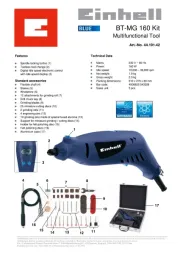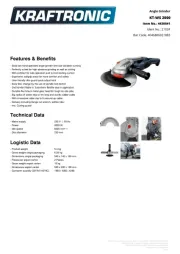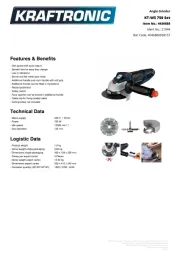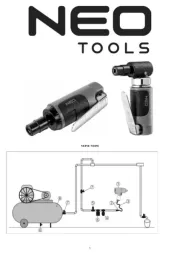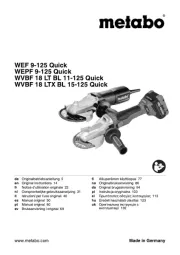AGB-2200U
WHAT’S IN THE BOX
Angle Grinder
Side Handle
Cutting & Grinding
Inner & Outer Flange
ANGLE GRINDER SAFETY WARNINGS
Pin Spanner &
Spare Brushes
ANGLE
GRINDER
230mm (9”) 2350W
ORIGINAL INSTRUCTIONS
SPECIFICATIONS
Rated Voltage: 230-240V ~50Hz
Motor: 2350W
Rated Speed: 6,000/min
Disc Diameter: 230mm
Spindle: M14
Bore: 22mm
Grinding Disc Thickness: 6mm
Protection Class: II
Weight (Tool Only): 4.7kg
ozito-diy.co.uk Cutting & Grinding Guard
OZITO UK Unit 9 Stadium Court, Wirral International Business Park, Plantation Road, Bromborough, Wirral, CH62 3QG
All of our products undergo strict quality checks to ensure that they reach
you in perfect condition. In the unlikely event that your device develops a
fault, please contact our service department at the address shown on this
guarantee card. You can also contact us by telephone using the customer
service number shown. Please note the following terms under which
guarantee claims can be made:
1. These warranty terms regulate additional warranty services, which the
manufacturer mentioned below promises to buyers of its new products
in addition to their statutory guarantee claims are not affected by this
guarantee. Our guarantee is free of charge to you.
2. The warranty services only covers defects due to material or
manufacturing faults on a product which you have bought from the
manufacturer mentioned below are limited to either the rectication of said
defects on the product or the replacement of the product, whichever we
prefer.
Please note that our devices are not designed for use in commercial, trade
or professional applications. A guarantee contract will not be created if the
device has been used by commercial, trade or industrial business or has
been exposed to similar stresses during the guarantee period.
3. The following are not covered by our guarantee:
- Damage to the device caused by a failure to follow the assembly
instructions or due to incorrect installation, a failure to follow the operating
instructions (for example connecting it to an incorrect mains voltage or
current type) or a failure to follow the maintenance and safety instructions
or by exposing the device to abnormal environmental conditions or by lack
of care and maintenance.
- Damage to the device caused by abuse or incorrect use (for example
overloading the device or the use or unapproved tools or accessories),
ingress of foreign bodies into the device (such as sand, stones or dust,
transport damage), the use of force or damage caused by external forces
(for example by dropping it).
- Damage to the device or parts of the device caused by normal or natural
wear or tear or by normal use of the device.
4. Your Product is guaranteed for a period of 36 months from the original
date of purchase and is intended for DIY (Do It Yourself) use only. Warranty
excludes consumable parts. Guarantee claims should be submitted
before the end of the guarantee period within two weeks of the defect
being noticed. No guarantee claims will be accepted after the end of the
guarantee period. The original guarantee period remains applicable to the
device even if repairs are carried out or parts are replaced. In such cases,
the work performed or parts tted will not result in an extension of the
guarantee period, and no new guarantee will become active for the work
performed or parts tted. This also applies if an on-site service is used.
IN ORDER TO MAKE A CLAIM UNDER THIS WARRANTY YOU MUST
RETURN THE PRODUCT TO THE PLACE OF PURCHASE WITH YOUR
REGISTER RECEIPT.
Please refer to the restrictions of this warranty concerning wearing parts,
consumables and missing parts as set out in the service information in
these operating instructions.
CUSTOMER SERVICE HELPLINE
GB: 0151 294 4488
IRL: 1850 882711
Ozito-diy.co.uk
WARRANTY
0118
WARNING! When using mains-powered tools, basic safety precautions, including the
following, should always be followed to reduce risk of re, electric shock, personal injury and
material damage.
Read the whole manual carefully and make sure you know how to switch the tool off in an emergency,
before operating the tool.
Save these instructions and other documents supplied with this tool for future reference.
Before you connect the equipment to the mains supply make sure that the data on the rating plate are identical to
the mains data.
This tool is double insulated therefore no earth wire is required.
If the supply cord is damaged, it must be replaced by an electrician or a power tool repairer in order to avoid a
hazard.
Note: Double insulation does not take the place of normal safety precautions when operating this tool. The
insulation system is for added protection against injury resulting from a possible electrical insulation failure within
the tool.
Using an Extension Lead
Always use an approved extension lead suitable for the power input of this tool. Before use, inspect the extension
lead for signs of damage, wear and ageing. Replace the extension lead if damaged or defective.
When using an extension lead on a reel, always unwind the lead completely. Use of an extension lead not suitable
for the power input of the tool or which is damaged or defective may result in a risk of re and electric shock.
GENERAL POWER TOOL SAFETY WARNINGS
ELECTRICAL SAFETY
WARNING! “Read all safety warnings, instructions, illustrations and specications provided
with this power tool.” Failure to follow the warnings and instructions may result in electric shock, re and/
or serious injury.
Save all warnings and instructions for future reference. The term “power tool” in the warnings refers to
your mains-operated (corded) power tool or battery-operated (cordless) power tool.
1. Work area safety
a. Keep work area clean and well lit. Cluttered or dark areas invite accidents.
b. Do not operate power tools in explosive atmospheres, such as in the presence of ammable liquids,
gases or dust. Power tools create sparks which may ignite the dust or fumes.
c. Keep children and bystanders away while operating a power tool. Distractions can cause you to lose
control.
2. Electrical safety
a. Power tool plugs must match the outlet. Never modify the plug in any way. Do not use any adapter
plugs with earthed (grounded) power tools. Unmodied plugs and matching outlets will reduce risk of
electric shock.
b. Avoid body contact with earthed or grounded surfaces, such as pipes, radiators, ranges and
refrigerators. There is an increased risk of electric shock if your body is earthed or grounded.
c. Do not expose power tools to rain or wet conditions. Water entering a power tool will increase the risk of
electric shock.
d. Do not abuse the cord. Never use the cord for carrying, pulling or unplugging the power tool. Keep
cord away from heat, oil, sharp edges or moving parts. Damaged or entangled cords increase the risk of
electric shock.
e. When operating a power tool outdoors, use an extension cord suitable for outdoor use. Use of a cord
suitable for outdoor use reduces the risk of electric shock.
f. If operating a power tool in a damp location is unavoidable, use a residual current device (RCD)
protected supply. Use of an RCD reduces the risk of electric shock.
3. Personal safety
a. Stay alert, watch what you are doing and use common sense when operating a power tool. Do not use
a power tool while you are tired or under the inuence of drugs, alcohol or medication. A moment of
inattention while operating power tools may result in serious personal injury.
b. Use personal protective equipment. Always wear eye protection. Protective equipment such as dust mask,
non-skid safety shoes, hard hat, or hearing protection used for appropriate conditions will reduce personal
injuries.
c. Prevent unintentional starting. Ensure the switch is in the off-position before connecting to power
source and/or battery pack, picking up or carrying the tool. Carrying power tools with your nger on the
switch or energising power tools that have the switch on invites accidents.
d. Remove any adjusting key or wrench before turning the power tool on. A wrench or a key left attached to
a rotating part of the power tool may result in personal injury.
e. Do not overreach. Keep proper footing and balance at all times. This enables better control of the power
tool in unexpected situations.
f. Dress properly. Do not wear loose clothing or jewellery. Keep your hair, clothing and gloves away from
moving parts. Loose clothes, jewellery or long hair can be caught in moving parts.
g. If devices are provided for the connection of dust extraction and collection facilities, ensure these are
connected and properly used. Use of dust collection can reduce dust-related hazards.
h) Do not let familiarity gained from frequent use of tools allow you to become complacent and ignore
tool safety principles. A careless action can cause severe injury within a fraction of a second.
4. Power tool use and care
a. Do not force the power tool. Use the correct power tool for your application. The correct power tool will
do the job better and safer at the rate for which it was designed.
b. Do not use the power tool if the switch does not turn it on and off. Any power tool that cannot be
controlled with the switch is dangerous and must be repaired.
c. Disconnect the plug from the power source and/or remove the battery pack, if detachable, from the
power tool before making any adjustments, changing accessories, or storing power tools. Such
preventive safety measures reduce the risk of starting the power tool accidentally.
d. Store idle power tools out of the reach of children and do not allow persons unfamiliar with the power
tool or these instructions to operate the power tool. Power tools are dangerous in the hands of untrained
users.
e. Maintain power tools and accessories. Check for misalignment or binding of moving parts, breakage of
parts and any other condition that may affect the power tool’s operation. If damaged, have the power
tool repaired before use. Many accidents are caused by poorly maintained power tools.
f. Keep cutting tools sharp and clean. Properly maintained cutting tools with sharp cutting edges are less likely
to bind and are easier to control.
g. Use the power tool, accessories and tool bits etc. in accordance with these instructions, taking into
account the working conditions and the work to be performed. Use of the power tool for operations
different from those intended could result in a hazardous situation.
h) Keep handles and grasping surfaces dry, clean and free from oil and grease. Slippery handles and
grasping surfaces do not allow for safe handling and control of the tool in unexpected situations.
5. Service
a. Have your power tool serviced by a qualied repair person using only identical replacement parts. This
will ensure that the safety of the power tool is maintained.
Safety Information for all Applications
a) This electric tool is designed for use as a grinder/sander and cutting-off machine. Obey all the safety
instructions, general instructions, illustrations and data supplied with the tool. If you fail to obey the following
instructions, you may suffer an electric shock, re and/or serious injuries.
b) This electric tool is not designed for sanding, working with wire brushes or polishing. Use of the electric
tool in ways it was not intended could lead to dangerous situations and injuries.
c) Do not use any accessories which have not been designed and recommended by the manufacturer
specically for this electric tool. Just because you can attach an accessory to your electric tool, this does not
guarantee that you can use it safely.
d) The maximum speed of the plug-in tool must be at least as high as the maximum speed specied on the
electric tool. Accessories which rotate faster than the maximum speed may break and be catapulted out of the tool.
e) The external diameter and thickness of the plug-in tool must comply with the dimension specications of
your electric tool. Plug-in tools of the wrong size cannot be adequately screened or checked.
f) Grinding wheels, anges, grinding disks or other accessories must t precisely on the grinding spindle
of your electric tool. Plug-in tools which do not t exactly on to the grinding spindle of the electric tool will rotate
irregularly, vibrate a great deal and may result in you losing control.
g) Do not use damaged plug-in tools. Before use, check plug-in tools such as grinding/sanding wheels for
splintering and cracks, grinding/sanding disks for cracks, wear or heavy wear, and wire brushes for loose
or broken wires. If the electric tool or the plug-in tool is dropped, check whether it is damaged or use an
undamaged plug-in tool. When you have checked and tted the plug-in tool, make sure that you and other
persons in the vicinity are not on a level with the rotating plug-in tool and allow the electric tool to run for
one minute at maximum speed. Damaged plug-in tools will generally break during this test time.
h) Wear personal protection equipment. Use face guards, eye protection or goggles depending on the
application. If reasonable, wear a dust mask, ear protection, safety gloves or special aprons to keep small
grinding and material particles away from you. Protect your eyes from ying foreign bodies which may be created
by a range of applications. Dust masks or respiration masks must lter the dust generated by the application. If you
are exposed to loud noise for a lengthy period of time, you may suffer hearing loss.
i) Ensure that others keep a safe distance away from where you are working. Anybody who enters the area
must wear personal protection equipment. Pieces of the workpiece or broken plug-in tools may be catapulted into
the air and cause injuries even outside the immediate vicinity of where you are working.
j) Hold the tool only by the insulated handles when carrying out work during which the plug-in tool could
strike concealed power cables or its own mains lead. Contact with a live cable will also make the metal parts of
the tool live and will cause an electric shock.
k) Keep the power cable away from rotating plug-in tools. If you lose control of the machine, the mains lead may
be cut or caught and your hand or arm might be pulled into the rotating plugin tool.
l) Never put the electric tool down until the plug-in tool has reached a complete standstill. The rotating plug-
in tool may come into contact with the surface on which you place it which could result in you losing control of the
electric tool.
m) Never leave the electric tool running whilst you are carrying it. Your clothing can come into contact with the
rotating plug-in tool and the plugin tool could thus bore into your body.
n) Clean the ventilation slots on your electric tool at regular intervals. The motor fan draws dust into the
housing and a heavy accumulation of metal dust can pose electric risks.
o) Never use the electric tool in the vicinity of inammable materials. Sparks may ignite these materials.
p) Do not use any plug-in tools which require liquid coolant. Use of water or other liquid coolants could result in
electric shocks.
Other safety information for all applications
Recoil is the sudden reaction as a result of a jammed or blocked rotating plug-in-tool, such as
a grinding wheel, grinding disks, wire brushes etc. Jamming or blocking leads to an abrupt stop of the rotating plugin-
tool. This causes acceleration of any uncontrolled electric tools rotating in the opposite direction to the plug-in-tool at
the point of blockage.
If for example a grinding wheel gets jammed or blocked by the workpiece, the edge of the grinding wheel could
get stuck and the grinding wheel could break free or recoil, if it should come into contact with the workpiece. The
grinding wheel moves toward or away from the operator, depending upon the direction of rotation of the disk at the
point of blockage. Grinding wheels could also be broken if this occurs.
Recoil is the result of incorrect or wrong use of the electric tool. It can be prevented by suitable precautions, as
described below.
a) Hold the electric tool securely and move your body and your arms into a position in which you can
absorb the force created by the recoil. Always use the additional handle (if there is one) to give you the
maximum possible control over recoil forces or reaction moments whilst the tool is operating at full speed.
The operator can manage the recoil and reaction forces by taking suitable precautions.
b) Never move your hand into the vicinity of rotating plug-in tools. The plug-in tool may catch your hand if it
suffers recoil.
c) Keep your body out the area into which the electric tool will be moved if it suffers recoil. Recoil will throw
the electric tool into the direction opposite to the grinding/sanding wheel at the point at which it is blocked.
d) Work with particular care around corners, sharp edges, etc. Ensure that the plug-in tool does not bounce
off or jam in the workpiece. At corners, sharp edges or if it bounces, the rotating plug-in tool will tend to jam. This
will result in loss of control or recoil.
e) Do not use chain saw blades or toothed saw blades. These plug-in tools often cause recoil or loss of control
of the electric tool.
Special safety information for grinding/sanding and cutting-off
a) Use only grinding/sanding wheels that have been approved for your electric tool and the safety hood
designed for these grinding/sanding wheels. Grinding/sanding wheels which are not designed for the electric tool
cannot be shielded adequately and are unsafe.
b) The safety hood must be securely fastened to the electric tool and adjusted so that it offers maximum
safety, in other words it prevents the smallest possible part of the grinding/sanding wheel from striking the
operator. The safety hood helps to protect the operator from broken pieces, accidental contact with the cutting-off
wheel, and sparks which could ignite clothing.
c) Grinding/sanding wheels may only be used for the applications for which they are recommended. For
example: Never grind/sand a side surface area with a cutting off wheel. Cutting-off wheels are designed for
removing material with the edge of the wheel. Applying lateral force to these cutting-off wheels can cause them to
break.
d) Always use undamaged clamping anges of the correct size and shape for the grinding/sanding wheel
you have selected. Suitable anges support the grinding/ sanding wheel and thus reduce the risk of the grinding/
sanding wheel breaking. Flanges for cutting-off wheels may differ from the anges for other grinding/sanding wheels.
e) Do not used worn grinding/sanding wheels from larger electric tools. Grinding/ sanding wheels for larger
electric tools are not designed for the higher speeds of smaller electric tools and may break.
Other special safety information for cutting off wheels
a) Avoid blocking the cutting-off wheel or applying excessive contact pressure. Do not make any
excessively deep cuts. Overloading the cutting-off wheel will increase the stress on it and its susceptibility to jam or
block and therefore the possibility of recoil or of the grinding wheel breaking.
b) Avoid the area in front of and behind the rotating cutting-off wheel. If you move the cutting-off wheel in
the workpiece away from yourself, in the event of recoil the electric tool and the rotating wheel may be catapulted
directly towards you.
c) If the cutting-off wheel jams or you interrupt your work, switch off the tool and hold it still until the wheel
has reached a complete standstill. Never attempt to pull the cuttingoff wheel out of the cut whilst it is still
rotating, otherwise it may suffer recoil. Find and rectify the cause of the jam.
d) Do not switch the electric tool on again whilst it is inside the workpiece. Allow the cuttingoff disk to reach
its full speed before you continue the cut with care. Otherwise the wheel may catch, jump out of the workpiece
or cause recoil.
e) Support panels or large workpieces to reduce the risk of recoil by a jammed cuttingoff wheel. Large
workpieces may sag under their own weight. The workpiece must be supported on both sides of the wheel both near
the cut and also at the edge.
f) Be particularly careful with “pocket cuts” in existing walls or in areas which you cannot see clearly. As the
cutting-off disk enters the cut it may suffer recoil if it cuts into gas or water pipes, electric cables or other objects.
MAINTENANCE TROUBLESHOOTING
• Keep the ventilation vents of the angle grinder clean at all times, if possible,
prevent foreign matter from entering the vents.
• The grease in the gearbox will require replacement / replenishment after
extensive use of the grinder. Please see a qualied electrical repairer to
provide this service.
• After each use, blow air through the angle grinder housing to ensure it is
free from all dust particles which may build up. Build up of dust particles may
cause the angle grinder to overheat and fail.
• If the enclosure of the angle grinder requires cleaning, do not use solvents but
a moist soft cloth only. Never let any liquid get inside the angle grinder; never
immerse any part of the angle grinder into a liquid.
Carbon Brushes
When the carbon brushes wear out, the angle
grinder will spark and/or stop. Discontinue use as
soon as this happens. They should be replaced
prior to recommencing use of the angle grinder.
Carbon brushes are a wearing component of the
angle grinder therefore not covered under warranty.
Continuing to use the angle grinder when carbon
brushes need to be replaced may cause permanent
damage Carbon brushes will wear out after many uses but when the carbon
brushes need to be replaced, take the angle grinder to an electrician or a power
tool repairer for a quick and low cost replacement. Always replace both carbon
brushes at the same time.
Note: Ozito Industries will not be responsible for any damage or injuries caused
by the repair of the angle grinder by an unauthorised person or by mishandling
of the angle grinder.
Sparking visible through the housing air vents
A small amount of sparking may be visible through the housing vents.
This is normal and does not indicate a problem.
Excessive sparking visible through the housing air vents
and/or the angle grinder failing to operate
May indicate the carbon brushes have worn out and need to be
replaced. Carbon brushes should only be replaced by a qualied
electrician or power tool repairer.
Guard lever will not close
The guard nut may be over tightened. Loosen guard nut slightly
and try to close guard lever again.
Guard lever closes but doesn’t securely fasten guard/ the
guard rattles or moves during tool use
The guard nut may not be tight enough. Tighten the guard nut
and then close the guard lever.
DESCRIPTION OF SYMBOLS
SPARE PARTS
Spare parts can be ordered from the Special Orders
Desk at your local Bunnings Warehouse or Homebase
store.
For further information, or any parts visit
www.ozito-diy.co.uk or contact Ozito Customer Service:
Great Britain: 0151 294 4488
Ireland: 1850 882711
E-mail: info@ozito-diy.co.uk
SERVICE INFORMATION
Danger! Read the operating instructions to reduce the risk of
inquiry.
Caution! Wear ear-muffs. The impact of noise can cause
damage to hearing.
Caution! Wear a breathing mask. Dust which is injurious to
health can be generated when working on wood and other
materials. Never use the device to work on any materials
containing asbestos!
Caution! Wear safety goggles. Sparks generated during
working or splinters, chips and dust emitted by the device can
cause loss of sight.
This safety guard is designed for sanding/
grinding.
This safety guard is designed for cutting and
grinding/sanding.
Double insulated
Please note that the following parts of this product are subject to normal
or natural wear and that the following parts are therefore also required
for use as consumables.
* Not necessarily included in the scope of delivery!
Category Example
Wear parts* Carbon brushes
Consumables* Cutting wheels, grinding wheels
Missing parts
SOUND & VIBRATION
DECLARATION OF CONFORMITY
For EU countries only
Never place any electric power tools in your household refuse.
To comply with European Directive 2012/19/EC concerning old electric
and electronic equipment and its implementation in national laws, old
electric power tools have to be separated from other waste and disposed
of in an environment-friendly fashion, e.g. by taking to a recycling depot.
Recycling alternative to the return request:
As an alternative to returning the equipment to the manufacturer, the
owner of the electrical equipment must make sure that the equipment is
properly disposed of if p1-he no longer wants to keep the equipment. The old
equipment can be returned to a suitable collection point that will dispose
of the equipment in accordance with the national recycling and waste
disposal regulations. This does not apply to any accessories or aids
without electrical components supplied with the old equipment.
The reprinting or reproduction by any other means, in whole or in part, of
documentation and papers accompanying products is permitted only with
the express consent of the iSC GmbH.
Subject to technical changes
Sound and vibration values were measured in accordance with EN
60745-2-3 and EN 60745-1.
Lpa sound pressure level: 99 dB (A)
Kpa uncertainty: 3 dB
Lwa sound power level: 110 dB (A)
Kwa uncertainty: 3 dB
Wear ear-muffs.
The impact of noise can cause damage to hearing.
Surface sanding/grinding
Vibration emission value a
hag = 8.56 m/s2
K uncertainty = 1.5 m/s2
The specied vibration value was established in accordance with a
standardized testing method. It may change according to how the electric
equipment is used and may exceed the specied value in exceptional
circumstances.
The specied vibration value can be used to compare the equipment with
other electric power tools.
The specied vibration value can be used for initial assessment of a
harmful effect.
Keep the noise emissions and vibrations to a minimum.
• Only use appliances which are in perfect working order.
• Service and clean the appliance regularly.
• Adapt your working style to suit the appliance.
• Do not overload the appliance.
• Have the appliance serviced whenever necessary.
• Switch the appliance off when it is not in use.
• Wear protective gloves.
Yang/Product-ManagementWeichselgartner/General-Manager
explains the following conformity according to EU directives and norms for
the following product
Angle Grinder AGB-2200U (Ozito)
2014/29/EU
2005/32/EC_2009/125/EC
2014/35/EU
2006/28/EC
X 2014/30/EU
2014/32/EU
2014/53/EC
2014/68/EU
90/396/EC_2009/142/EC
89/686/EC_96/58/EC
X 2011/65/EU
X 2006/42/EC
Annex IV
Notied Body:
Notied Body No.:
Reg. No.:
2000/14/EC_2005/88/EC
Annex V
Annex VI
Noise: measured L
WA = dB (A); guaranteed LWA = dB (A)
P = KW; L/Ø = cm
Notied Body:
2012/46/EU
Emission No.:
Standard references: EN 60745-1; EN 60745-2-3;
EN 55014-1; EN 55014-2; EN 61000-3-2; EN 61000-3-3
Landau/Isar, den 08.12.2017
First CE: 17 Archive-File/Record: NAPR018144
Art.-No.: 30.001.55 I.-No.: 11027 Documents registrar: Alex Kurz
Subject to change without notice Wiesenweg 22, D-94405 Landau/Isar
ISC GmbH · Eschenstraße 6 · D-94405 Landau/Isar




